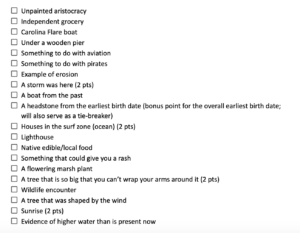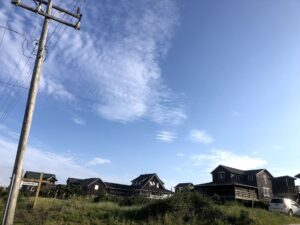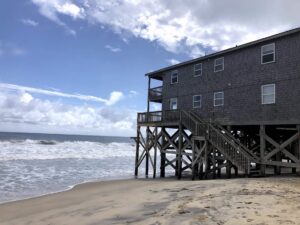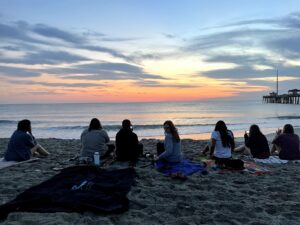Hello, I’m Blakely Durham, a current sophomore majoring in Environmental Studies. This semester I had the privilege of interning for the North Carolina Coastal Federation in Wanchese. The Coastal Fed works to protect coastal waters and habitats along the NC coast.
Throughout my internship, I had the opportunity to tag along with Coastal Fed staff to learn about some of their ongoing work. My first opportunity to do so was with my mentor Michael Flynn during the Coastal Fed’s Abandoned and Derelict Vessel (ADV) Removal project. I was especially intrigued by this project because during my short time in the Outer Banks I couldn’t help but notice the two sailboats stranded by the shore near the Washington Baum Bridge. Initially I thought they were just anchored there for the day, but I learned they were actually stuck and abandoned by their owners. For this project, I got to spend the whole day on the water, which was very refreshing. Throughout the boat ride, I learned more specifics of the project, like how the Coastal Fed contracted people to do the work, the guidelines for removal, and all the grants and permitting that allowed the ADV removal to occur. During this whole day, however, only one boat was removed, and it was “an easy one.” So when my mentor asked me to join him for a second day on the water, I respectfully declined.
Another project I learned about was the Lake Mattamuskeet Watershed Restoration project. Lake Mattamuskeet was the largest naturally formed lake in North Carolina, but so much human modification occurred that it is no longer considered a natural lake. A number of canals were dug to move water, and the lake was even split in two by a highway, creating an East and West basin with little water exchange. Toxic algal blooms occur throughout, and residents must consistently pump water to avoid flooding of their lands. All and all, it’s a very bad situation. I attended a stakeholder and public meeting with my mentor in Swan Quarter to meet the people involved with the proposed management plan and hear concerns from citizens. It was definitely a very informative experience, as I got to see how various stakeholders with different concerns interacted while all working towards the same end goal.
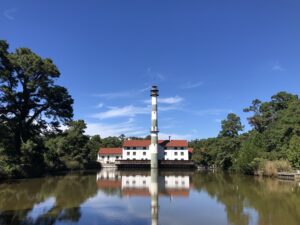
My final “field trip” was to First Flight Middle School with Sara Hallas, the Coastal Fed’s education coordinator, to teach 6th graders about the rain garden in front of their school. For the first activity, we assigned each group of kids a specific plant to find using a handy-dandy sheet with pictures of all the plants in the rain garden. The second activity of the rain garden lesson was “stewardship.” For this activity, we gave each group of kids specific instructions to care for their assigned plant. They attacked their tasks with lots of enthusiasm, sometimes perhaps a little too much. I enjoyed this chance to be outside and work with kids again. It was also heart-warming to watch some of the kids who were so eager to learn and help out.
While these specific projects allowed me to get a more well-rounded view of the Coastal Fed’s work, the majority of my work surrounded offshore wind in NC. Currently there are two offshore wind projects proposed off the coast of NC. One in Kitty Hawk has already been leased and is in the prospecting phase. The other in Wilmington is still in the leasing phase. Though offshore wind has major benefits, namely providing a source of renewable energy, its presence in the marine environment can have a variety of other impacts. My job was to write a paper detailing the impacts of the installation of offshore wind farms off of NC’s coast. This involved a lot of research, reading up on all the potential economic and environmental impacts as well as public perception of offshore wind. I was unaware of offshore wind’s impacts or specific projects in NC before, so I learned a lot during this process. For this project I most enjoyed reading the studies on the public’s opinions on offshore wind and what informs these opinions.
This project also allowed me to learn more about the process to actually get to installation. There is a lot of back and forth, with drafts released for public comment, then revised and re-released for almost every step in the process. And so many acronyms: WEAs (wind energy area), EAs (environmental assessment), PSNs (proposed sale notice), NOIs (notice of intent), and EISs (environmental impact statement) to name a few.
Writing the offshore wind paper, I learned a lot about offshore wind’s environmental impacts. Some of them are positive, but the majority seemed to be negative. It made me realize that no project will ever be perfect. If we want offshore wind, which we do, we need to accept that there will be some negative environmental impacts. It then becomes increasingly important to learn about those impacts, so they can be managed in a way that reduces them as much as possible. Because at the end of the day it does no one any good to be locked in a stalemate trying to find the ever-elusive “perfect” solution. So I’m glad that I got to be an even small part of this process, striving for information to reduce the impacts.
** I would consider the Coastal Fed for an internship if you don’t mind a desk job, but still want an opportunity to get out and work in the community. It is also a very small office, so you have a chance to meet everyone working there and explore different aspects of the Coastal Fed’s work. **
